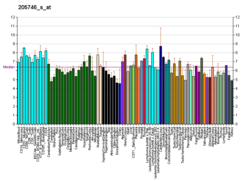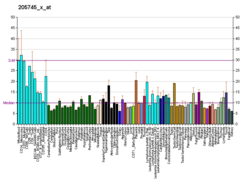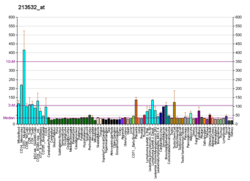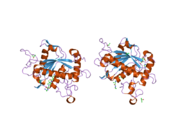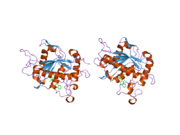A disintegrin and metalloprotease 17 (ADAM17), also called TACE (tumor necrosis factor-α-converting enzyme), is a 70-kDa enzyme that belongs to the ADAM protein family of disintegrins and metalloproteases, activated by substrate presentation.
Structure
ADAM17 is an 824-amino acid polypeptide.
ADAM17 has multidomain structure that includes a pro-domain, a metallo-protease domain, a disintegrin domain, a cysteine-rich domain, an EGF-like domain, a transmembrane domain, and a cytoplasmic tail. The metalloprotease domain is responsible for the enzyme's catalytic activity, cleaving membrane-bound proteins, including cytokines like TNF-alpha, to release their soluble forms. The disintegrin and cysteine-rich domains are implicated in cell adhesion and interaction with integrins, while the transmembrane domain anchors the protein in the membrane. The cytoplasmic tail is involved in intracellular signaling and protein-protein interactions. ADAM17's activity is tightly regulated through multiple mechanisms, including the removal of its pro-domain and interactions with regulatory proteins such as TIMPs (tissue inhibitors of metalloproteinases).
Function
ADAM17 is understood to be involved in the processing of tumor necrosis factor alpha (TNF-α) at the surface of the cell, and from within the intracellular membranes of the trans-Golgi network. This process, which is also known as 'shedding', involves the cleavage and release of a soluble ectodomain from membrane-bound pro-proteins (such as pro-TNF-α), and is of known physiological importance. ADAM17 was the first 'sheddase' to be identified, and is also understood to play a role in the release of a diverse variety of membrane-anchored cytokines, cell adhesion molecules, receptors, ligands, and enzymes.
Cloning of the TNF-α gene revealed it to encode a 26 kDa type II transmembrane pro-polypeptide that becomes inserted into the cell membrane during its maturation. At the cell surface, pro-TNF-α is biologically active, and is able to induce immune responses via juxtacrine intercellular signaling. However, pro-TNF-α can undergo a proteolytic cleavage at its Ala76-Val77 amide bond, which releases a soluble 17kDa extracellular domain (ectodomain) from the pro-TNF-α molecule. This soluble ectodomain is the cytokine commonly known as TNF-α, which is of pivotal importance in paracrine signaling. This proteolytic liberation of soluble TNF-α is catalyzed by ADAM17.
ADAM17 may play a prominent role in the Notch signaling pathway, during the proteolytic release of the Notch intracellular domain (from the Notch1 receptor) that occurs following ligand binding. ADAM17 also regulates the MAP kinase signaling pathway by regulating shedding of the EGFR ligand amphiregulin in the mammary gland. ADAM17 also has a role in the shedding of L-selectin, a cellular adhesion molecule.
Activation
The localization of ADAM17 is speculated to be an important determinant of shedding activity. TNF-α processing has classically been understood to occur in the trans-Golgi network, and be closely connected to transport of soluble TNF-α to the cell surface. Shedding is also associated with clustering of ADAM17 with its substrate, membrane bound TNF, in lipid rafts. The overall process is called substrate presentation and regulated by cholesterol. Research also suggests that the majority of mature, endogenous ADAM17 may be localized to a perinuclear compartment, with only a small amount of TACE being present on the cell surface. The localization of mature ADAM17 to a perinuclear compartment, therefore, raises the possibility that ADAM17-mediated ectodomain shedding may also occur in the intracellular environment, in contrast with the conventional model.
Functional ADAM17 has been documented to be ubiquitously expressed in the human colon, with increased activity in the colonic mucosa of patients with ulcerative colitis, a main form of inflammatory bowel disease. Other experiments have also suggested that expression of ADAM17 may be inhibited by ethanol.
Interactions
ADAM17 has been shown to interact with:
Clinical significance
Adam17 may facilitate entry of the SARS‑CoV‑2 virus, possibly by enabling fusion of virus particles with the cytoplasmic membrane. Adam17 has similar ACE2 cleavage activity as TMPRSS2, but by forming soluble ACE2, Adam17 may actually have the protective effect of blocking circulating SARS‑CoV‑2 virus particles.
Adam17 sheddase activity may contribute to COVID-19 inflammation by cleavage of TNF-α and Interleukin-6 receptor.
Recently, ADAM17 was discovered as a crucial mediator of resistance to radiotherapy. Radiotherapy can induce a dose-dependent increase of furin-mediated cleavage of the ADAM17 proform to active ADAM17, which results in enhanced ADAM17 activity in vitro and in vivo. It was also shown that radiotherapy activates ADAM17 in non-small cell lung cancer, which results in shedding of multiple survival factors, growth factor pathway activation, and radiotherapy-induced treatment resistance.
References
- ^ GRCh38: Ensembl release 89: ENSG00000151694 – Ensembl, May 2017
- ^ GRCm38: Ensembl release 89: ENSMUSG00000052593 – Ensembl, May 2017
- "Human PubMed Reference:". National Center for Biotechnology Information, U.S. National Library of Medicine.
- "Mouse PubMed Reference:". National Center for Biotechnology Information, U.S. National Library of Medicine.
- Black RA, Rauch CT, Kozlosky CJ, Peschon JJ, Slack JL, Wolfson MF, et al. (February 1997). "A metalloproteinase disintegrin that releases tumour-necrosis factor-alpha from cells". Nature. 385 (6618): 729–733. Bibcode:1997Natur.385..729B. doi:10.1038/385729a0. PMID 9034190. S2CID 4251053.
- Moss ML, Jin SL, Milla ME, Bickett DM, Burkhart W, Carter HL, et al. (February 1997). "Cloning of a disintegrin metalloproteinase that processes precursor tumour-necrosis factor-alpha". Nature. 385 (6618): 733–736. Bibcode:1997Natur.385..733M. doi:10.1038/385733a0. PMID 9034191. S2CID 4335616.
- Primakoff P, Myles DG (February 2000). "The ADAM gene family: surface proteins with adhesion and protease activity". Trends in Genetics. 16 (2): 83–87. doi:10.1016/s0168-9525(99)01926-5. PMID 10652535.
- Seals DF, Courtneidge SA (January 2003). "The ADAMs family of metalloproteases: multidomain proteins with multiple functions". Genes & Development. 17 (1): 7–30. doi:10.1101/gad.1039703. PMID 12514095.
- Blobel CP (January 2005). "ADAMs: key components in EGFR signalling and development". Nature Reviews. Molecular Cell Biology. 6 (1): 32–43. doi:10.1038/nrm1548. PMID 15688065.
- Edwards DR, Handsley MM, Pennington CJ (October 2008). "The ADAM metalloproteinases". Molecular Aspects of Medicine. 29 (5): 258–289. doi:10.1016/j.mam.2008.08.001. PMC 7112278. PMID 18762209.
- Sternlicht MD, Sunnarborg SW, Kouros-Mehr H, Yu Y, Lee DC, Werb Z (September 2005). "Mammary ductal morphogenesis requires paracrine activation of stromal EGFR via ADAM17-dependent shedding of epithelial amphiregulin". Development. 132 (17): 3923–3933. doi:10.1242/dev.01966. PMC 2771180. PMID 16079154.
- Li Y, Brazzell J, Herrera A, Walcheck B (October 2006). "ADAM17 deficiency by mature neutrophils has differential effects on L-selectin shedding". Blood. 108 (7): 2275–2279. doi:10.1182/blood-2006-02-005827. PMC 1895557. PMID 16735599.
- Tellier E, Canault M, Rebsomen L, Bonardo B, Juhan-Vague I, Nalbone G, et al. (December 2006). "The shedding activity of ADAM17 is sequestered in lipid rafts". Experimental Cell Research. 312 (20): 3969–3980. doi:10.1016/j.yexcr.2006.08.027. PMID 17010968.
- Taïeb J, Delarche C, Ethuin F, Selloum S, Poynard T, Gougerot-Pocidalo MA, et al. (December 2002). "Ethanol-induced inhibition of cytokine release and protein degranulation in human neutrophils". Journal of Leukocyte Biology. 72 (6): 1142–1147. doi:10.1189/jlb.72.6.1142. PMID 12488495. S2CID 9712196.
- Peiretti F, Deprez-Beauclair P, Bonardo B, Aubert H, Juhan-Vague I, Nalbone G (May 2003). "Identification of SAP97 as an intracellular binding partner of TACE". Journal of Cell Science. 116 (Pt 10): 1949–1957. doi:10.1242/jcs.00415. PMID 12668732.
- Nelson KK, Schlöndorff J, Blobel CP (November 1999). "Evidence for an interaction of the metalloprotease-disintegrin tumour necrosis factor alpha convertase (TACE) with mitotic arrest deficient 2 (MAD2), and of the metalloprotease-disintegrin MDC9 with a novel MAD2-related protein, MAD2beta". The Biochemical Journal. 343 Pt 3 (Pt 3): 673–680. doi:10.1042/0264-6021:3430673. PMC 1220601. PMID 10527948.
- Poghosyan Z, Robbins SM, Houslay MD, Webster A, Murphy G, Edwards DR (February 2002). "Phosphorylation-dependent interactions between ADAM15 cytoplasmic domain and Src family protein-tyrosine kinases". The Journal of Biological Chemistry. 277 (7): 4999–5007. doi:10.1074/jbc.M107430200. PMID 11741929.
- Díaz-Rodríguez E, Montero JC, Esparís-Ogando A, Yuste L, Pandiella A (June 2002). "Extracellular signal-regulated kinase phosphorylates tumor necrosis factor alpha-converting enzyme at threonine 735: a potential role in regulated shedding". Molecular Biology of the Cell. 13 (6): 2031–2044. doi:10.1091/mbc.01-11-0561. PMC 117622. PMID 12058067.
- Grieve A, Xu H, Künzel U, Bambrough P, Sieber B, Freeman M (April 2017). "Phosphorylation of iRhom2 at the plasma membrane controls mammalian TACE-dependent inflammatory and growth factor signalling". eLife. 6. doi:10.7554/eLife.23968. PMC 5436907. PMID 28432785.
- ^ Zipeto D, Palmeira JD, Argañaraz GA, Argañaraz ER (2020). "ACE2/ADAM17/TMPRSS2 Interplay May Be the Main Risk Factor for COVID-19". Frontiers in Immunology. 11: 576745. doi:10.3389/fimmu.2020.576745. PMC 7575774. PMID 33117379.
- Sharma A, Bender S, Zimmermann M, Riesterer O, Broggini-Tenzer A, Pruschy MN (September 2016). "Secretome Signature Identifies ADAM17 as Novel Target for Radiosensitization of Non-Small Cell Lung Cancer". Clinical Cancer Research. 22 (17): 4428–4439. doi:10.1158/1078-0432.CCR-15-2449. PMID 27076628.
Further reading
- Black RA (January 2002). "Tumor necrosis factor-alpha converting enzyme". The International Journal of Biochemistry & Cell Biology. 34 (1): 1–5. doi:10.1016/S1357-2725(01)00097-8. PMID 11733179.
- Bonaldo MF, Lennon G, Soares MB (September 1996). "Normalization and subtraction: two approaches to facilitate gene discovery". Genome Research. 6 (9): 791–806. doi:10.1101/gr.6.9.791. PMID 8889548.
- Black RA, Rauch CT, Kozlosky CJ, Peschon JJ, Slack JL, Wolfson MF, et al. (February 1997). "A metalloproteinase disintegrin that releases tumour-necrosis factor-alpha from cells". Nature. 385 (6618): 729–733. Bibcode:1997Natur.385..729B. doi:10.1038/385729a0. PMID 9034190. S2CID 4251053.
- Moss ML, Jin SL, Milla ME, Bickett DM, Burkhart W, Carter HL, et al. (February 1997). "Cloning of a disintegrin metalloproteinase that processes precursor tumour-necrosis factor-alpha". Nature. 385 (6618): 733–736. Bibcode:1997Natur.385..733M. doi:10.1038/385733a0. PMID 9034191. S2CID 4335616.
- Maskos K, Fernandez-Catalan C, Huber R, Bourenkov GP, Bartunik H, Ellestad GA, et al. (March 1998). "Crystal structure of the catalytic domain of human tumor necrosis factor-alpha-converting enzyme". Proceedings of the National Academy of Sciences of the United States of America. 95 (7): 3408–3412. Bibcode:1998PNAS...95.3408M. doi:10.1073/pnas.95.7.3408. PMC 19849. PMID 9520379.
- Patel IR, Attur MG, Patel RN, Stuchin SA, Abagyan RA, Abramson SB, et al. (May 1998). "TNF-alpha convertase enzyme from human arthritis-affected cartilage: isolation of cDNA by differential display, expression of the active enzyme, and regulation of TNF-alpha". Journal of Immunology. 160 (9): 4570–4579. doi:10.4049/jimmunol.160.9.4570. PMID 9574564. S2CID 54023449.
- Schroeter EH, Kisslinger JA, Kopan R (May 1998). "Notch-1 signalling requires ligand-induced proteolytic release of intracellular domain". Nature. 393 (6683): 382–386. Bibcode:1998Natur.393..382S. doi:10.1038/30756. PMID 9620803. S2CID 4431882.
- Hirohata S, Seldin MF, Apte SS (November 1998). "Chromosomal assignment of two ADAM genes, TACE (ADAM17) and MLTNB (ADAM19), to human chromosomes 2 and 5, respectively, and of Mltnb to mouse chromosome 11". Genomics. 54 (1): 178–179. doi:10.1006/geno.1998.5544. PMID 9806848.
- Lum L, Wong BR, Josien R, Becherer JD, Erdjument-Bromage H, Schlöndorff J, et al. (May 1999). "Evidence for a role of a tumor necrosis factor-alpha (TNF-alpha)-converting enzyme-like protease in shedding of TRANCE, a TNF family member involved in osteoclastogenesis and dendritic cell survival". The Journal of Biological Chemistry. 274 (19): 13613–13618. doi:10.1074/jbc.274.19.13613. PMID 10224132.
- Cerretti DP, Poindexter K, Castner BJ, Means G, Copeland NG, Gilbert DJ, et al. (August 1999). "Characterization of the cDNA and gene for mouse tumour necrosis factor alpha converting enzyme (TACE/ADAM17) and its location to mouse chromosome 12 and human chromosome 2p25". Cytokine. 11 (8): 541–551. doi:10.1006/cyto.1998.0466. PMID 10433800.
- Nelson KK, Schlöndorff J, Blobel CP (November 1999). "Evidence for an interaction of the metalloprotease-disintegrin tumour necrosis factor alpha convertase (TACE) with mitotic arrest deficient 2 (MAD2), and of the metalloprotease-disintegrin MDC9 with a novel MAD2-related protein, MAD2beta". The Biochemical Journal. 343 Pt 3 (Pt 3): 673–680. doi:10.1042/0264-6021:3430673. PMC 1220601. PMID 10527948.
- Kärkkäinen I, Rybnikova E, Pelto-Huikko M, Huovila AP (June 2000). "Metalloprotease-disintegrin (ADAM) genes are widely and differentially expressed in the adult CNS". Molecular and Cellular Neurosciences. 15 (6): 547–560. doi:10.1006/mcne.2000.0848. PMID 10860581. S2CID 36643322.
- Brou C, Logeat F, Gupta N, Bessia C, LeBail O, Doedens JR, et al. (February 2000). "A novel proteolytic cleavage involved in Notch signaling: the role of the disintegrin-metalloprotease TACE". Molecular Cell. 5 (2): 207–216. doi:10.1016/S1097-2765(00)80417-7. PMID 10882063.
- Lee MH, Verma V, Maskos K, Nath D, Knäuper V, Dodds P, et al. (May 2002). "Engineering N-terminal domain of tissue inhibitor of metalloproteinase (TIMP)-3 to be a better inhibitor against tumour necrosis factor-alpha-converting enzyme". The Biochemical Journal. 364 (Pt 1): 227–234. doi:10.1042/bj3640227. PMC 1222565. PMID 11988096.
- Lee MH, Verma V, Maskos K, Becherer JD, Knäuper V, Dodds P, et al. (June 2002). "The C-terminal domains of TACE weaken the inhibitory action of N-TIMP-3". FEBS Letters. 520 (1–3): 102–106. Bibcode:2002FEBSL.520..102L. doi:10.1016/S0014-5793(02)02776-X. PMID 12044879. S2CID 1433047.
- Díaz-Rodríguez E, Montero JC, Esparís-Ogando A, Yuste L, Pandiella A (June 2002). "Extracellular signal-regulated kinase phosphorylates tumor necrosis factor alpha-converting enzyme at threonine 735: a potential role in regulated shedding". Molecular Biology of the Cell. 13 (6): 2031–2044. doi:10.1091/mbc.01-11-0561. PMC 117622. PMID 12058067.
- Mohan MJ, Seaton T, Mitchell J, Howe A, Blackburn K, Burkhart W, et al. (July 2002). "The tumor necrosis factor-alpha converting enzyme (TACE): a unique metalloproteinase with highly defined substrate selectivity". Biochemistry. 41 (30): 9462–9469. doi:10.1021/bi0260132. PMID 12135369.
- Gómez-Gaviro MV, González-Alvaro I, Domínguez-Jiménez C, Peschon J, Black RA, Sánchez-Madrid F, et al. (October 2002). "Structure-function relationship and role of tumor necrosis factor-alpha-converting enzyme in the down-regulation of L-selectin by non-steroidal anti-inflammatory drugs". The Journal of Biological Chemistry. 277 (41): 38212–38221. doi:10.1074/jbc.M205142200. PMID 12147693.
- Zheng Y, Schlondorff J, Blobel CP (November 2002). "Evidence for regulation of the tumor necrosis factor alpha-convertase (TACE) by protein-tyrosine phosphatase PTPH1". The Journal of Biological Chemistry. 277 (45): 42463–42470. doi:10.1074/jbc.M207459200. PMID 12207026.
External links
- CD156b+Antigen at the U.S. National Library of Medicine Medical Subject Headings (MeSH)
- Human ADAM17 genome location and ADAM17 gene details page in the UCSC Genome Browser.
- Human ADAM18 genome location and ADAM18 gene details page in the UCSC Genome Browser.
| PDB gallery | |
|---|---|
|
| Proteins: clusters of differentiation (see also list of human clusters of differentiation) | |
|---|---|
| 1–50 | |
| 51–100 | |
| 101–150 | |
| 151–200 | |
| 201–250 | |
| 251–300 | |
| 301–350 | |
| Proteases: metalloendopeptidases (EC 3.4.24) | |
|---|---|
| ADAM proteins | |
| Matrix metalloproteinases | |
| Other | |
| Enzymes | |
|---|---|
| Activity | |
| Regulation | |
| Classification | |
| Kinetics | |
| Types |
|





